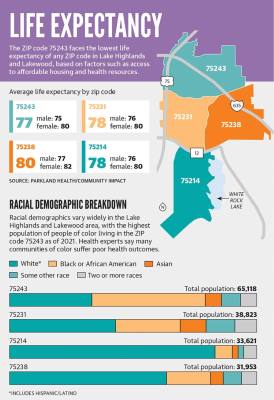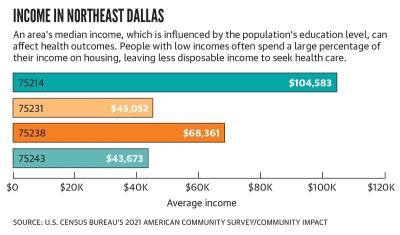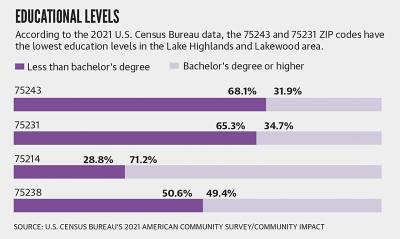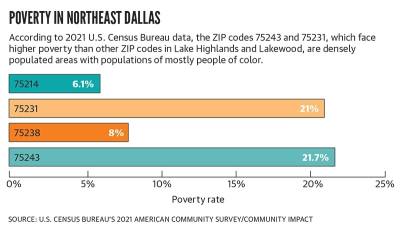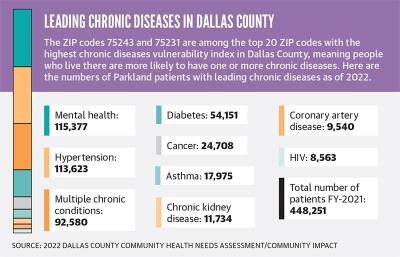County data shows people living in the ZIP code 75243—which is a high-poverty, minority-majority census tract—face lower life expectancies and poorer health outcomes than people living in more affluent areas of Lake Highlands and Lakewood, such as the ZIP codes 75214, 75231 and 75238. Factors such as lower income, lower education rates and a lack of nearby health resources, such as grocery stores and health clinics, contribute to the lower overall health of the community.
In Lake Highlands, the ZIP code 75243 “emerged as a hotspot” of high health risks in the northern section of Dallas County in Parkland Health’s 2022 Dallas County Community Health Needs Assessment, said Teresita Oaks, director of Community Health Programs for Parkland.
“That is important because what that is telling you is that there have been some changes that require attention,” Oaks said.
The ZIP codes 75243 and 75231, which include the northern section of Lake Highlands, rank in the top 20 of Dallas County’s 84 ZIP codes with a high population of people who suffer from one or more chronic diseases. In low-income areas, such as those ZIP codes, people are less likely to be able to seek treatment for those diseases.
Influencing health outcomes
Dohyeong Kim, associate dean of graduate education and public policy professor at The University of Texas at Dallas, said low-income communities, such as the 75243 ZIP code, are often exposed to negative factors, such as high stress and violent crime, that can lead to poor long-term health. At the same time, they lack the resources to combat those factors on their own.
“Education, income, employment, housing, health care: those five things are really circular,” Kim said. “Good education leads to a good job; a good job leads to a good income; a good income leads to a good environment and also access to health care.”
When looking at the cost of healthy food options compared to some junk foods, many are forced to buy the less nutritional option, Oaks said. Milk or juice may cost more than soda and not go as far, so those living in poverty are likely to choose it even when they know the milk or juice would be a better option, she said.
“[Low-income] families still need to feed their kids,” Oaks said. “They buy what they can afford that will feed the most with the money they have.”
Housing affects health
In addition to less access to healthy food, medicine and housing, low-income families are often less likely to live in areas near spaces that would encourage physical activities.
An area’s poverty rate and access to affordable housing directly affects its health outcomes, Oaks said. A person with a low income is more likely to have to spend a larger percent of their income on housing, which makes it harder to spend money on things to take care of themselves.
“If a family is struggling to pay for their housing, they’re less likely to put effort into medication or go to the doctor,” Oaks said.
In Lake Highlands, there are several low-income and mixed-income housing projects in front of Dallas City Council that could provide new affordable housing options.
Kathy Stewart, District 10 City Council member-elect, said she supports the county’s plan for an affordable housing development at 8350 Forest Lane as well as the proposed supportive housing project that would replace a hotel known for violent crime at 9019 Vantage Point Drive. However, she said she does not support the development of Cypress Creek at Forest Lane, a mixed-income housing project that would be located at 11520 N. Central Expressway. She cited concerns about crime and the lack of a nearby grocery store as reasons for her lack of support.
Breaking the cycle
Growing up in a low-income family or neighborhood affects people’s ability to create change for themselves, Oaks said. Children who grow up in high-income neighborhoods and pursue higher education their parents pay for will have an easier time saving money, buying a home and securing a high-paying job than those who grow up in a low-income neighborhood, Oaks said. In turn, those from high-income neighborhoods will be able to get quality health care that can lead to better long-term health and a longer life.
“There’s this belief that people choose to be poor, choose to be sick, and that’s not ... true,” Oaks said.
City leaders must think outside of the box and look for new opportunities to invest in their communities while strengthening economic development, Oaks said. To her, those opportunities should be driven by the community itself.
“I can’t go and tell a community, ‘This is what you need to do,’” Oaks said. “I’d rather ask the community, ‘What do you need,’ and address those issues.”
Identifying needs
In ZIP code 75243, and the rest of Lake Highlands and Lakewood, city leaders must look at which of the five pillars of health—education, income, employment, housing and health care—is most lacking in order to address each neighborhood’s health outcomes, Kim said.
City leaders can work to improve the health outcomes in low-income neighborhoods by pushing to add healthy grocery options and affordable health clinics, Kim said. Many low-income communities have low health awareness because of their lifestyle and lack of health education, so health awareness campaigns, such as vaccine drives, could also help.
Even with limited resources, small steps can lead to a big change, Kim said.
One new development in ZIP code 75243, the Forest Audelia Park and Multipurpose Center, is expected to bring community resources and help revitalize the neighborhood. The $7.55 million project, which city leaders expect to be complete in two to three years, will include a park with sport courts as well as a multipurpose center with a cultural center, recreation center, library, police station and boxing gym.
During her upcoming term as the Lake Highlands representative, Stewart said she hopes to be able to address health needs with a data-focused lens by researching her community before solidifying her approach to a specific area or ZIP code.
“We’re going to have actual facts and data that tell us what a neighborhood is made up of and ... what their needs are,” Stewart said.





